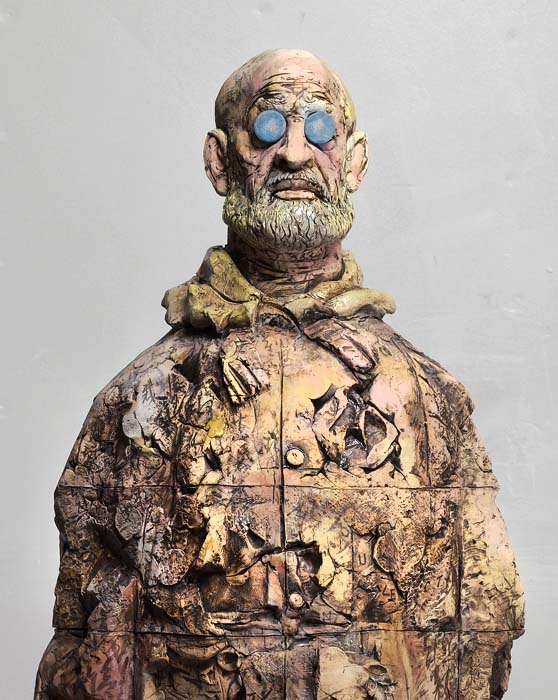Interviewsand Articles
From the Editor w&c #25: Transcending Cultural Boundaries
by , Mar 6, 2017

left and below: Wanxin Zhang
The work for this issue was already in place and no unifying theme had appeared. But in a conversation with Rue Harrison, a theme came into focus—the transcendence of cultural boundaries. Take sculptor Wanxin Zhang. Here’s an artist whose life has been a journey across cultural boundaries. His work exemplifies art’s potential, maybe not so often realized, of speaking at the level where we’re all more alike than we are different. Although much of his work is rooted in reference to the great archeological find of thousands of terra cotta warriors commissioned by the first emperor of China, it speaks to some of the timeless questions we face today.
Sculptor Sam Perry’s work is simply beautiful. No translations are needed. For many years, he was Viola Frey’s studio assistant. During those years clay was the medium he used for his own work. I remember seeing some of it when I interviewed Viola in 2000. But standing alone among several of his large works in clay were a couple of elegant wooden bowls that immediately caught my attention. The promise so evident in those bowls was a preview of what was to come. His shift to wood as a medium seemed to liberate a feeling for the lyrical that had been missing earlier.
And in this issue, for the first time we take a voyage into the realm of music, perhaps the supreme art form for crossing cultural boundaries. From a dictionary, music is defined as: an art of sound in time that expresses ideas and emotions in significant forms through the elements of rhythm, melody, harmony, and color. Okay. But what about the mystery of how a musical phrase of a few notes or chords can create an immediate response in our feelings? Or how is it that a particular singer’s voice might move us to tears while another’s has little impact?
Gail Needleman tells us that music is really mathematics and physics. Something about the relationship between number and music has been recognized across many cultures for a long time. Our bodies are subject to the laws of physics, and music is a phenomenon of vibrations. With its overtones, music extends into subtle realms. And do we really understand the subtle realms of our perception?
Singer, songwriter, choral director and teacher Melanie DeMore is full of vitality and a sense of mission. She talks about how, after many years of experience, her focus is now on creating spontaneous community through group singing. With the right kind of guidance, the boundaries among strangers can be erased, she says. And she talks about the importance in singing of inhabiting one’s own body. In cultures worldwide these things have been known for millennia and are still true today.
Mary Stein contributes a revelatory memory from her childhood days of struggle with piano lessons. One day, listening to the radio, she heard for the first time a classical string quartet. Hearing the artful give and take among instruments opened a vision for her of the possibilities of human exchange and work together.
Anne Veh shares her reflections about a beloved kindergarten teacher and local legend, Betty Peck: "Living a Life of Gratitude." As Veh writes, "Betty refers to Kindergarten with a capital 'K.'"
And In this issue, we conclude our installments over nine issues of Enrique Martínez Celaya’s remarkable meditation on art and value: Guide. We’re grateful for having been able to bring it to a broader audience.
As readers of previous issues will know, the adventures of Indigo Animal continue, even after having reached a perfect denouement in issue #22. Now a new adventure is underway.
Finally, I remembered Michael Stillwater’s beautiful film about choral composer Morten Lauridsen, Shining Night. It’s the first feature-length film from his Song without Borders series: In Search of the Great Song. Hmm... song without borders. I like the sound of that.—rw
SUBSCRIBE NOW
TO OUR MONTHLY NEWSLETTER









Share Your Comments and Reflections on this Conversation: